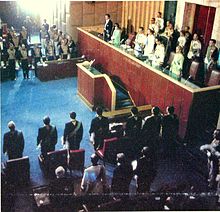Senate of Iran
Senate | |
|---|---|
| Type | |
| Type | of Iran |
| History | |
| Founded | 25 January 1950[1] |
| Disbanded | 11 February 1979 |
| Seats | 60 |
| Elections | |
First election | 1949 |
Last election | 1975 |
| Meeting place | |
 | |
| Tehran, Iran | |
| Constitution | |
| Persian Constitution of 1906 | |
The Senate (Persian: مجلس سنا, romanized: Majles-e Senā) was the upper house legislative chamber in Imperial State of Iran from 1949 to 1979. A bicameral legislature had been established in the 1906 Persian Constitutional Revolution but the Senate was not actually formed until after the Iran Constituent Assembly, 1949, as an expression of Shah Mohammad Reza Pahlavi's desire for more political power. The Senate was filled mainly with men who were supportive of the Shah's aims, as intended by the Shah. Half of the sixty seats in the senate were directly appointed by the Shah, fifteen represented Tehran, and the rest were elected from other regions.[2]
The Senate was disbanded after the Iranian Revolution in 1979, when the new constitution established a unicameral legislature. As of 2018 the former Senate building was used by the Assembly of Experts.
History[]
Constitution[]
Established as per Chapter 3, Article 45 of the Persian Constitution of 1906,
The Members of this Assembly shall be chosen from amongst the well-informed, discerning, pious and respected persons of the Realm. Thirty of them shall be nominated on the part of His Imperial Majesty (fifteen of the people of Tehran, and fifteen of the people of the Provinces), and thirty by the Nation (fifteen elected by the people of Tehran, and fifteen by the people of the Provinces).
Building[]
The Senate House of Iran was designed by architect Heydar Ghiaï in 1955.[3] The construction was led by Rahmat Safai, the dome being one of the most technically challenging projects in the entire endeavor.
The building is depicted on the reverse of the Iranian 100 rials banknote.[4]

Interior Dome of Senate Chamber, Heydar Ghiaï, Architect

Column of main Facade, Heydar Ghiaï, Architect
Members[]

- Mahmoud Hessaby (1951–1963).
- Ali Dashti for 1954-1979.[5]
- Jafar Sharif-Emami, Prime Minister of Iran (1960-1961 & 1978), was a member of the Iranian Senate.[6][7] He was its President[8] for a number of years.
- Jamshid Aalam (1973–1979)
List of speakers[]
This section does not cite any sources. (June 2018) |
| Name | Term of office | |
|---|---|---|
| Ebrahim Hakimi | 19 August 1951 | 1 March 1957 |
| Hassan Taqizadeh | 1 March 1957 | 1 September 1960 |
| Mohsen Sadr | 11 September 1960 | 11 September 1964 |
| Jafar Sharif-Emami | 11 September 1964 | 24 March 1978 |
| 24 March 1978 | 10 February 1979 | |
Dissolution[]
Following the Iranian revolution in 1979, the government became unicameral, the senate was dissolved and the new Majlis convened in the senate building.
Composition of elective seats[]
This section needs expansion. You can help by . (June 2018) |
| Year | Majority seats | Opposition seats | Ref | ||
|---|---|---|---|---|---|
| Party | Seats | Party | Seats | ||
| 1963 | New Iran Party | Unknown | People's Party | Unknown | [citation needed] |
| 1967 | 26 / 30 (87%)
|
4 / 30 (13%)
|
IPU | ||
| 1971 | 28 / 30 (93%)
|
2 / 30 (7%)
|
IPU | ||
| 1975 | Resurgence Party | 30 / 30 (100%)
|
N/A | IPU | |
Major events[]

- 1950 (February 9), first inaugural session presided over by Mohammad Reza Pahlavi.
- 1952, Mohammad Mosaddegh managed to obtain power to rule by decree — first, for a six-month period and then extended — due to his popularity. Later, he organized a plebiscite in 1953, won the votes, and dissolved both the Majlis and Senate.[9] Upon Mossadeq's ouster, the legislative bodies were revived.
- 1961, Mohammad Reza Pahlavi dissolved both the Majlis and Senate;[10] some time later they were restored.
- 1979 Senate approves the government of Shapour Bakhtiar.[11]
Bibliography[]
- M. Ghiai, Iran Senate House, Max Gerard Edt.Draeger Paris, 1976 ISBN 2-85119-008-3
References and notes[]
- ^ Haddad Adel, Gholamali; Elmi, Mohammad Jafar; Taromi-Rad, Hassan. "The Reign of Pahlavi II". The Pahlavi Dynasty: An Entry from Encyclopaedia of the World of Islam. EWI Press. p. 96. ISBN 9781908433022.
- ^ Donald Newton Wilber (2014). Iran, Past and Present: From Monarchy to Islamic Republic. Princeton University Press. p. 230. ISBN 1400857473.
- ^ Max Gérard, Iran Senate House Heydar Ghiaï, Editions Draeger, 1976
- ^ Central Bank of Iran. Banknotes & Coins: 100 Rials. – Retrieved on 24 March 2009.
- ^ Muslims (Library of Religious Beliefs and Practices), page 213, ISBN 978-0-415-34882-9
- ^ Iranian.com | Archive Pages
- ^ [http://ibexpub.com/index.php?main_page=pubs_product_book_info&cPath=5&products_id=89 Memoirs of Sharif-Emami, Prime Minister Persian Language ISBN 0-932885-22-5
- ^ IRANIAN ORAL HISTORY PROJECT HARVARD UNIVERSITY
- ^ Historical Setting: MOSSADEQ AND OIL NATIONALIZATION
- ^ Confidential, U.S. State Department, Central Files IRAN, 1960-January 1963, Internal Affairs and Foreign Affairs
- ^ "Iranian senate's approval of Shahpour Bakhtiar's government noted" ABC Evening News for Monday, Jan 15, 1979
Coordinates: 35°41′16.82″N 51°23′58.72″E / 35.6880056°N 51.3996444°E
- Senate of Iran
- 1949 in Iran
- Legislature of Iran
- Buildings and structures in Tehran
- National upper houses



